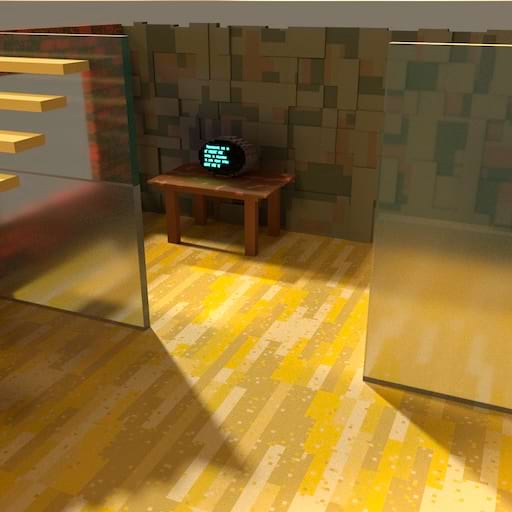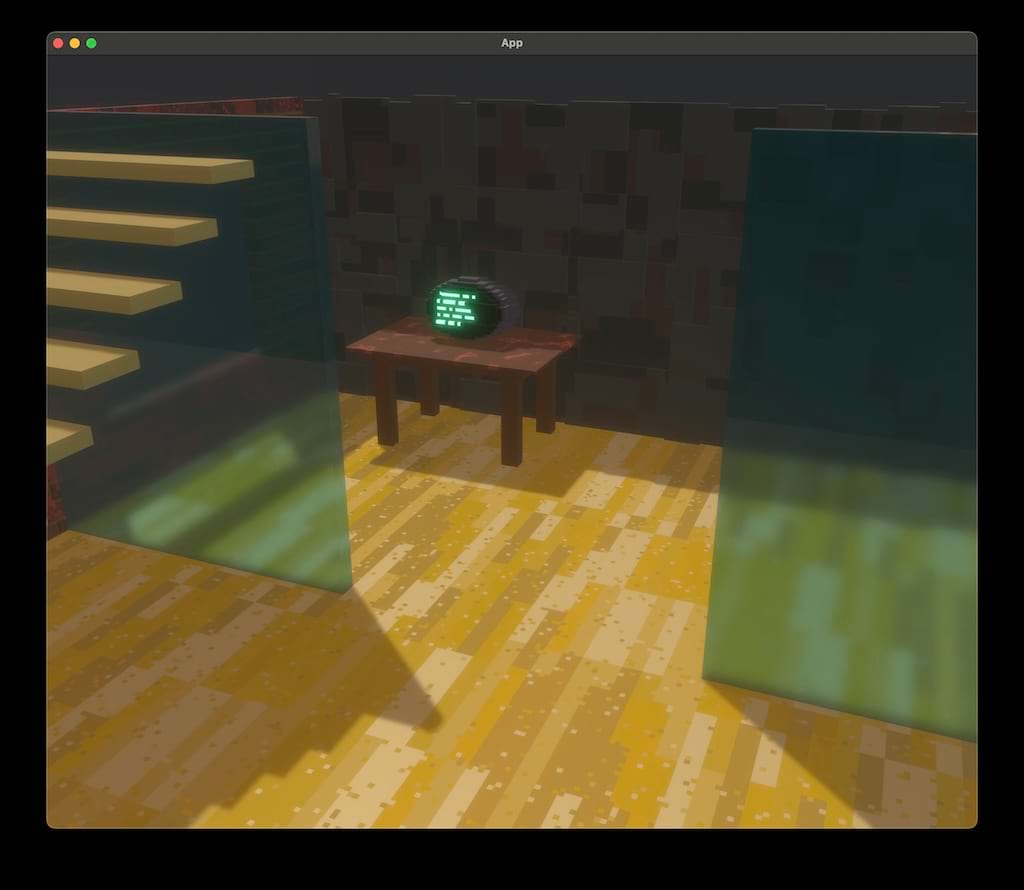21 releases (10 breaking)
Uses new Rust 2024
| 0.19.0 | Apr 26, 2025 |
|---|---|
| 0.18.0 | Jan 11, 2025 |
| 0.17.1 | Dec 10, 2024 |
| 0.16.0 | Nov 29, 2024 |
| 0.13.0 | Feb 22, 2024 |
#20 in Data formats
150 downloads per month
120KB
2.5K
SLoC
bevy_vox_scene
A plugin for the Bevy Engine which allows loading Magica Voxel .vox files directly into a Bevy scene graph.
bevy_vox_scene is forked from the excellent bevy_vox_mesh crate.
Why bevy-vox-scene?
Whereas other voxel crates load a single model with voxel colors but no other material properties, bevy_vox_scene can load an entire scene graph from a Magica Voxel world file, and it attempts to recreate the material properties from Magica Voxel's render tab. This means you can produce a scene in Bevy that approximates Magica Voxel's raytraced renders, but at Bevy's real-time interactive framerates.
Use Magica Voxel as your Bevy level editor.
Here is the study example scene as rendered by Magica Voxel's raytracer:

And this is the same scene in Bevy:

All Magica Voxel material types except "cloud" are supported. Bevy's screen space transmission does a great job of rendering glass materials.
bevy_vox_scene achieves this by generating a series of texture atlases for the scene to capture the differing color, metalness, roughness, emission, and transparency for each Voxel type in the scene.
Usage
- Add the crate using the command line (
cargo add bevy_vox_scene) or by adding it toCargo.toml:
[dependencies]
bevy_vox_scene = "0.19.0"
Then in code:
use bevy::prelude::*;
use bevy_vox_scene::VoxScenePlugin; // 2.
fn main() {
App::new()
.add_plugins((
DefaultPlugins,
VoxScenePlugin::default()
)) // 3.
.add_systems(Startup, setup)
.run();
}
fn setup(mut commands: Commands, assets: Res<AssetServer>) {
commands.spawn(SceneRoot(assets.load("study.vox#workstation/desk"))); //4
}
- Import the library.
- Add the plugin to the app.
- Spawn a scene graph using
SceneRoot. Alternatively, spawn any node of the scene graph, down to individual models, using the name you assigned to the node in MagicaVoxel.
Take a look in the examples/ directory for complete working examples. To run an example, type the following into the terminal:
cargo run --example <example name>
- To modify entities within a scene hierarchy using bevy observers, see the
modify-sceneexample. - If you want glowing emissive voxels, add an HDR and bloom-enabled camera. See the
emissive-modelexample. - Enabling Screen-Space Ambient Occlusion can give your voxel scenes more pop. See the
ssao-modelexample. - If you want glass voxels to refract other objects in the scene, enable specular transmission on your camera3d. See the
transmission-sceneexample. - If you want to render cloud voxels as volumetric fog, add
VolumetricFogto your camera, andVolumetricLightto your lights.bevy-vox-scenewill convert cloud voxels into density textures and insert them into your scene asFogVolumes. See thecloud-sceneexample.
Bevy and Magica Voxel compatibility
| Bevy version | Magica Voxel version | bevy-vox-scene version |
|---|---|---|
| 0.12 | 0.99.6, 0.99.7 | 0.9, 0.10, 0.11, 0.12 |
| 0.13 | 0.13 | |
| 0.14 | 0.14, 0.15 | |
| 0.15 | 0.16 | |
| - support cloud materials | 0.17 | |
| - support animation | 0.18 | |
| 0.16 | 0.19 |
Limitations and workarounds
- When spawning individual named meshes as subassets (
assets.load("study.vox#desk")), you'll need to ensure that the name you have given it in Magica Voxel is unique within the file. Avoid names that begin with the wordmaterialormodelas these are reserved for the various subassets that make up the scene. - In MagicaVoxel's raytraced renders, emissive materials contribute to the lighting of a scene. Emissive materials do not currently do this in Bevy, they just glow. If in future Bevy implements a global illumination system, then emissive materials would contribute to the lighting.
- Material properties (color, roughness, metalness, emission, transparency) are achieved using 16x16 pixel texture atlases that are indexed from the meshes UVs. Therefore it isn't possible to do "Minecraft" style texturing (where a texture is tiled over each voxel). For that effect, consider using the
bevy_vox_meshcrate instead.
Transparent materials
TLDR: split up models containing glass voxels into convex chunks using Magica Voxel's world editor.
Magica Voxel tip: you might need to manually move the transmissive models to last in Magica Voxel's render order for other models in the scene to be visible through them. Tap "Order -> Last" on the model that has the glass voxels. Although the scene hierarchy will be imported into Bevy with
VoxelSceneBundle, the ordering of sibling nodes in Magica Voxel files has no effect on bevy rendering.
- If you have a concave model that contains glass voxels, the other parts of that model will not be visible through the glass voxels. This is a limitation of Bevy's screen-space specular transmission system. To work around this limitation, use the Magica Voxel world editor to break up models that contain glass elements into separate models that are each convex.
- Bevy's StandardMaterial only allows a single Index of Refraction (IoR) per material. The IoR contained in a model are averaged together to arrive at this value. If your scene contains transmissive materials that have widely differing IoRs (eg water vs diamond), and you think that averaging those IoRs together makes a significant visible difference to the scene, consider breaking the model up into separate meshes for each transmissive medium.
Acknowledgements
Forked from the excellent bevy_vox_mesh crate by Lucas A.
Like bevy-vox-mesh, bevy-vox-scene uses dot-vox to parse the vox files and the greedy mesher from block-mesh-rs (https://github.com/bonsairobo/block-mesh-rs) to create efficient meshes.
Dependencies
~48–81MB
~1.5M SLoC